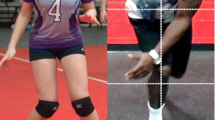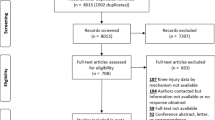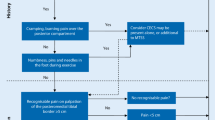Abstract
Purpose
The pivot shift (PS) test is commonly used to diagnose and evaluate the dynamic instability of the knee joint in cases of anterior cruciate ligament (ACL) tear. There is a need of a reliable and inexpensive tool which is easily available to measure PS objectively in a clinical setting. The purpose of this study was to evaluate the use of a smartphone, which is readily available, to assess the PS phenomenon.
Methods
Seventeen patients with unilateral ACL-injured knees, undergoing ACL reconstruction, were enrolled in the study. PS was initially graded according to the International Knee Documentation Committee classification by two observers. The PS test was then performed by them in normal and injured knees under anaesthesia using a smartphone attached to Gerdy’s tubercle. Acceleration changes during the PS test were recorded using the smartphone accelerometer application. Intra-observer and inter-observer reliability of the test among the two observers were evaluated. Acceleration changes were compared between the injured and normal knees, and also between the clinical grades of PS. Diagnostic utility of the smartphone accelerometer was examined by a receiver operating characteristic curve analysis.
Results
Intra-observer and inter-observer reliability were high for the smartphone accelerometer. The acceleration change was higher in the ACL-injured knees than in normal knees. The mean acceleration change was 2.54 m/s2 (SD = 0.97) in ACL-injured knees and 0.73 m/s2 (SD = 0.19) in normal knees (p < 0.001). The mean acceleration change of Grade 1 knees was 1.89 m/s2 (SD = 0.57), and that of knees of Grade 2 and above were 2.99 m/s2 (SD = 0.95) (p < 0.05). Sensitivity was 94% and specificity was 100% for the acceleration change required to detect ACL injury, i.e., 1.24 m/s2.
Conclusions
The results show that a smartphone can be used to evaluate the PS quantitatively and reliably, in the diagnosis of ACL injury.
Level of evidence
II.





Similar content being viewed by others
Abbreviations
- PS:
-
Pivot shift
- ACL:
-
Anterior cruciate ligament
- ROC:
-
Receiver operating characteristic
- IKDC:
-
International Knee Documentation Committee
- ICC:
-
Intraclass correlation coefficient
- AUC:
-
Area under curve
- EMS:
-
Electromagnetic measurement system
References
Ahlden M, Araujo P, Hoshino Y, Samuelsson K, Middleton KK, Nagamune K et al (2012) Clinical grading of the pivot shift test correlates best with tibial acceleration. Knee Surg Sports Traumatol Arthrosc 20:708–712
Almquist PO, Arnbjornsson A, Zatterstrom R, Ryd L, Ekdahl C, Friden T (2002) Evaluation of an external device measuring knee joint rotation: an in vivo study with simultaneous Roentgen stereometric analysis. J Orthop Res 20:427–432
Araujo PH, Ahlden M, Hoshino Y, Muller B, Moloney G, Fu FH et al (2012) Comparison of three non-invasive quantitative measurement systems for the pivot shift test. Knee Surg Sports Traumatol Arthrosc 20:692–697
Atkinson G, Nevill AM (1998) Statistical methods for assessing measurement error (reliability) in variables relevant to sports medicine. Sports Med 26:217–238
Berruto M, Uboldi F, Gala L, Marelli B, Albisetti W (2013) Is triaxial accelerometer reliable in the evaluation and grading of knee pivot-shift phenomenon? Knee Surg Sports Traumatol Arthrosc 21:981–985
Bignozzi S, Zaffagnini S, Lopomo N, Martelli S, Iacono F, Marcacci M (2009) Does a lateral plasty control coupled translation during antero-posterior stress in single-bundle ACL reconstruction? An in vivo study. Knee Surg Sports Traumatol Arthrosc 17:65–70
Bleday RM, Fanelli GC, Giannotti BF, Edson CJ, Barrett TA (1998) Instrumented measurement of the posterolateral corner. Arthroscopy 14:489–494
Borgstrom PH, Markolf KL, Wang Y, Xu XY, Yang PR, Joshi NB et al (2015) Use of inertial sensors to predict pivot-shift grade and diagnose an ACL injury during preoperative testing. Am J Sports Med 43:857–864
Burdock EI, Fleiss JL, Hardesty AS (1963) A new view of inter-observer agreement. Pers Psychol 16:373–384
Galway HR, MacIntosh DL (1980) The lateral pivot shift: a symptom and sign of anterior cruciate ligament insufficiency. Clin Orthop Relat Res 147:45–50
Hefti F, Muller W, Jakob RP, Staubli HU (1993) Evaluation of knee ligament injuries with the IKDC form. Knee Surg Sports Traumatol Arthrosc 1:226–234
Hoshino Y, Araujo P, Ahlden M, Moore CG, Kuroda R, Zaffagnini S et al (2012) Standardized pivot shift test improves measurement accuracy. Knee Surg Sports Traumatol Arthrosc 20:732–736
Hoshino Y, Araujo P, Ahlden M, Samuelsson K, Muller B, Hofbauer M et al (2013) Quantitative evaluation of the pivot shift by image analysis using the iPad. Knee Surg Sports Traumatol Arthrosc 21:975–980
Hoshino Y, Araujo P, Irrgang JJ, Fu FH, Musahl V (2012) An image analysis method to quantify the lateral pivot shift test. Knee Surg Sports Traumatol Arthrosc 20:703–707
Hoshino Y, Kuroda R, Nagamune K, Yagi M, Mizuno K, Yamaguchi M et al (2007) In vivo measurement of the pivot-shift test in the anterior cruciate ligament-deficient knee using an electromagnetic device. Am J Sports Med 35:1098–1104
Irrgang JJ, Ho H, Harner CD, Fu FH (1998) Use of the International Knee Documentation Committee guidelines to assess outcome following anterior cruciate ligament reconstruction. Knee Surg Sports Traumatol Arthrosc 6:107–114
Jakob RP, Staubli HU, Deland JT (1987) Grading the pivot shift. Objective tests with implications for treatment. J Bone Joint Surg Br 69:294–299
Kocher MS, Steadman JR, Briggs KK, Sterett WI, Hawkins RJ (2004) Relationships between objective assessment of ligament stability and subjective assessment of symptoms and function after anterior cruciate ligament reconstruction. Am J Sports Med 32:629–634
Kopf S, Kauert R, Halfpaap J, Jung T, Becker R (2012) A new quantitative method for pivot shift grading. Knee Surg Sports Traumatol Arthrosc 20:718–723
Kuroda R, Hoshino Y, Araki D, Nishizawa Y, Nagamune K, Matsumoto T et al (2012) Quantitative measurement of the pivot shift, reliability, and clinical applications. Knee Surg Sports Traumatol Arthrosc 20:686–691
Kuroda R, Hoshino Y, Nagamune K, Kubo S, Nishimoto K, Araki D et al (2008) Intraoperative measurement of pivot shift by electromagnetic sensors. Oper Tech Orthop 18:190–195
Labbe DR, Li D, Grimard G, de Guise JA, Hagemeister N (2015) Quantitative pivot shift assessment using combined inertial and magnetic sensing. Knee Surg Sports Traumatol Arthrosc 23:2330–2338
Lopomo N, Signorelli C, Bonanzinga T, Marcheggiani Muccioli GM, Visani A, Zaffagnini S (2012) Quantitative assessment of pivot-shift using inertial sensors. Knee Surg Sports Traumatol Arthrosc 20:713–717
Lopomo N, Signorelli C, Rahnemai-Azar AA, Raggi F, Hoshino Y, Samuelsson K et al (2017) Analysis of the influence of anaesthesia on the clinical and quantitative assessment of the pivot shift: a multicenter international study. Knee Surg Sports Traumatol Arthrosc 25:3004–3011
Lopomo N, Zaffagnini S, Amis AA (2013) Quantifying the pivot shift test: a systematic review. Knee Surg Sports Traumatol Arthrosc 21:767–783
Lopomo N, Zaffagnini S, Bignozzi S, Visani A, Marcacci M (2010) Pivot-shift test: analysis and quantification of knee laxity parameters using a navigation system. J Orthop Res 28:164–169
Lopomo N, Zaffagnini S, Signorelli C, Bignozzi S, Giordano G, Marcheggiani Muccioli GM et al (2012) An original clinical methodology for non-invasive assessment of pivot-shift test. Comput Methods Biomech Biomed Eng 15:1323–1328
Maeyama A, Hoshino Y, Debandi A, Kato Y, Saeki K, Asai S et al (2011) Evaluation of rotational instability in the anterior cruciate ligament deficient knee using triaxial accelerometer: a biomechanical model in porcine knees. Knee Surg Sports Traumatol Arthrosc 19:1233–1238
Matsumoto H (1990) Mechanism of the pivot shift. J Bone Jt Surg Br 72:816–821
McGraw KO, Wong SP (1996) Forming inferences about some intraclass correlation coefficients. Psychol Methods 1:30–46
Musahl V, Griffith C, Irrgang JJ, Hoshino Y, Kuroda R, Lopomo N et al (2016) Validation of quantitative measures of rotatory knee laxity. Am J Sports Med 44:2393–2398
Musahl V, Hoshino Y, Ahlden M, Araujo P, Irrgang JJ, Zaffagnini S et al (2012) The pivot shift: a global user guide. Knee Surg Sports Traumatol Arthrosc 20:724–731
Nakamura K, Koga H, Sekiya I, Watanabe T, Mochizuki T, Horie M et al (2017) Evaluation of pivot shift phenomenon while awake and under anaesthesia by different manoeuvres using triaxial accelerometer. Knee Surg Sports Traumatol Arthrosc 25:2377–2383
Noyes FR, Grood ES, Cummings JF, Wroble RR (1991) An analysis of the pivot shift phenomenon. The knee motions and subluxations induced by different examiners. Am J Sports Med 19:148–155
Prins M (2006) The Lachman test is the most sensitive and the pivot shift the most specific test for the diagnosis of ACL rupture. Aust J Physiother 52:66–66
Tanaka T, Hoshino Y, Miyaji N, Ibaragi K, Nishida K, Nishizawa Y et al (2018) The diagnostic reliability of the quantitative pivot-shift evaluation using an electromagnetic measurement system for anterior cruciate ligament deficiency was superior to those of the accelerometer and iPad image analysis. Knee Surg Sports Traumatol Arthrosc 26:2835–2840
Un BS, Beynnon BD, Churchill DL, Haugh LD, Risberg MA, Fleming BC (2001) A new device to measure knee laxity during weightbearing and non-weightbearing conditions. J Orthop Res 19:1185–1191
Funding
None.
Author information
Authors and Affiliations
Contributions
RKV: data analysis, interpretation, and drafting manuscript; CWY: design, data acquisition, and analysis; JL: data acquisition, analysis, and data interpretation; H-SH: design and data acquisition; MCL: data interpretation and manuscript revision; DHR: design, drafting, and revision of manuscript.
Corresponding author
Ethics declarations
Conflict of interest
The authors certify that they have no commercial association that might pose a conflict of interest in connection with this article.
Ethical approval
This study was approved by the institutional review board of Seoul National University College of Medicine, Seoul National University Hospital (IRB No. H-1707-030-867).
Additional information
Publisher's Note
Springer Nature remains neutral with regard to jurisdictional claims in published maps and institutional affiliations.
Electronic supplementary material
Below is the link to the electronic supplementary material.
Rights and permissions
About this article
Cite this article
Vaidya, R.K., Yoo, C.W., Lee, J. et al. Quantitative assessment of the pivot shift test with smartphone accelerometer. Knee Surg Sports Traumatol Arthrosc 28, 2494–2501 (2020). https://doi.org/10.1007/s00167-019-05826-3
Received:
Accepted:
Published:
Issue Date:
DOI: https://doi.org/10.1007/s00167-019-05826-3




